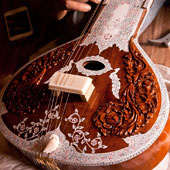.
Sitar Making - Miraj, Maharashtra
Sitar is considered to be one of the folk instruments of ancient India that occupies the place of pride in the Indian musical instruments, which is believed to be descending of the long neck lutes that came to India from central Asia. Miraj is the city located at the southern part of Maharashtra gives a platform for the makers of the sitar.
Sitar is one of the key instruments in Hindustani music with three strings, which belongs to the lute family where the strings of the instruments are parallel to its resonator and having bowed chordophone. The word sitar is taken from the Persian word sihtar that means three strings and tar from Punjabi language-meaning string. It is believed that sitar was introduced by Persians and Turks between 11th to 12th centuries in India that had only three strings and later the strings are increased due to the influence of veena.
It is believed that sitar evolved in the Indo- Pakistan subcontinent during the Mughal era and was one among the famous instrument that was played in the Mughal court. Sitar was one among the charming musical instrument played in the Mughal court during their period of reign. The passion for the string instrument was very much supported by Raja Ravi Varma, as he was mesmerized with the fine tonal quality and lightweight of the sitar. He also provided support and encouragement to the Persian artisans who were at his approach. Many of Raja Ravi varma’s paintings illustrate goddess holding or playing sitar that shows the influence and importance of the string instruments during his time.
In the Indian culture there is so much of respect for the musical instruments as they are like part of God quoted from the famous sitarist (sitar playing person) Pandit Ravi Shankar. The influence of sitar can be largely seen towards the north side of India due to the Mughal dynasty impact. The captivate music from the strings of sitar has attracted many well known musical artist around the globe, musical bands like the Beatles and the Rolling Stones use sitar for their performance. The sitar of modern era has evolved from its original design, the changes could be seen are of the tonal quality of instrument, usage of plectrum, way of Raga Alap and treatment of the ragas. Most of the sitar manufacturers /industry are well-established and producing fine quality products. Many of these shops are about 150 years old and situated in the remote part of India, Miraj in Maharashtra provides great business opportunity for well-tuned and crafted (made) sitar, which is used by the professional and classical musicians.
Musicians usually hold the sitar at an angle of 450 to their laps while seated on the ground and pluck the strings with a wire plectrum held by the right hand forefinger. Left hand fingers manipulate the strings and apply pressure on or between the frets with sideways pulls of the strings. Many craftsmen involved in manufacturing this instruments since decades and continuing as a family business, G. S. Musicals is one such instrument manufacturer can be contacted in Miraj of Maharashtra.







